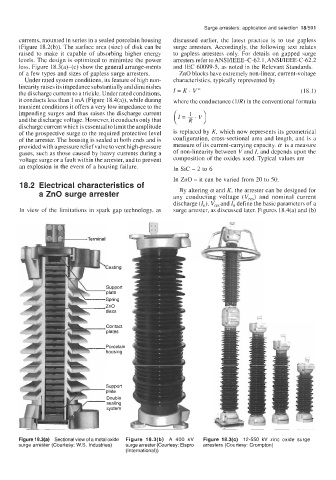Page 626 - Industrial Power Engineering and Applications Handbook
P. 626
Surge arresters: application and selection 18/591
currents, mounted in series in a sealed porcelain housing discussed earlier, the latest practice is to use gapless
(Figure 18.2(b)). The surface area (size) of disk can be surge arresters. Accordingly, the following text relates
raised to make it capable of absorbing higher energy to gapless arresters only. For details on gapped surge
levels. The design is optimized to minimize the power arresters refer to ANSMEEE-C-62.1, ANSImEE-C-62.2
loss. Figure 18.3(a)-(c) show the general arrange-ments and IEC 60099-5, as noted in the Relevant Standards.
of a few types and sizes of gapless surge arresters. ZnO blocks have extremely non-linear, current-voltage
Under rated system conditions, its feature of high non- characteristics, typically represented by
linearity raises its impedance substantially and diminishes
the discharge current to a trickle. Under rated conditions, I=K.V" (18.1)
it conducts less than 1 mA (Figure 18.4(a)), while during where the conductance (1/R) in the conventional formula
transient conditions it offers a very low impedance to the
impending surges and thus raises the discharge current (I = + . v)
and the discharge voltage. However, it conducts only that
discharge current which is essential to limit the amplitude
of the prospective surge to the required protective level is replaced by K, which now represents its geometrical
of the arrester. The housing is sealed at both ends and is configuration, cross-sectional area and length, and is a
provided with a pressure relief valve to vent high-pressure measure of its current-carrying capacity. a is a measure
gases, such as those caused by heavy currents during a of non-linearity between V and I, and depends upon the
voltage surge or a fault within the arrester, and to prevent composition of the oxides used. Typical values are
an explosion in the event of a housing failure. In Sic - 2 to 6
In ZnO - it can be varied from 20 to 50.
18.2 Electrical characteristics of
By altering a and K, the arrester can be designed for
a ZnO surge arrester any conducting voltage (Vres) and nominal current
discharge (I"). Vresand I, define the basic parameters of a
In view of the limitations in spark gap technology, as surge arrester, as discussed later. Figures 18.4(a) and (b)
Casting
support
plate
Spring
ZnO
discs
Contact
plates
Porcelain
housing
'.
support
plate
Double
sealing
system
l - 4
Figure 18.3(a) Sectional view of a metal oxide Figure 18.3(b) A 400 kV Figure 18.3(c) 12-550 kV zinc oxide surge
surge arrester (Courtesy: W.S. Industries) surge arrester (Courtesy: Elspro arresters (Courtesy: Crompton)
(International))

